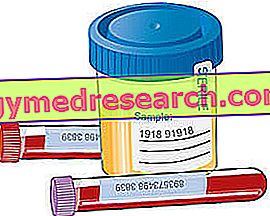Generality
Gastroesophageal reflux and diet are closely related to each other, in terms of causes, therapy and prevention.

Brief review of gastroesophageal reflux
In medicine, the phenomenon by which gastric juices rise from the stomach to the esophagus, reaching even the throat in the most serious cases, is called gastroesophageal reflux or gastric reflux .
Gastroesophageal reflux sporadically affects many people and can, in some circumstances, become a chronic disorder; when it becomes chronic, it represents a real disease, whose specific name is gastroesophageal reflux disease but which, in common jargon, is simply called (and again) gastroesophageal reflux.
In industrialized countries, gastroesophageal reflux disease is considered a rather common condition, since, according to some statistics, it affects between 20 and 40% of people aged between 45 and 64 years.
When it is chronic, gastroesophageal reflux is due to a malfunction of the cardia, that is the valve that, placed between the esophagus and the stomach, prevents the food from rising from it.
Among the factors that can affect the functioning of the cardia, there are conditions such as obesity, cigarette smoking, hiatal hernia, asthma, the constant intake of certain medicines, pregnancy, stress and poor nutrition to greet.
To cope with chronic gastroesophageal reflux, you need:
- A drug therapy based on medicines such as antacids, alginates, anti-H2 and proton pump inhibitors, which buffer gastric acidity and / or reduce the production of acid digestive juices from the stomach,
is
- An appropriate diet therapy, which increases the tone of the cardia rather than relaxing it excessively, which keeps the intra-abdominal pressure at low levels rather than increasing it and which leads to an acid secretion contained by the stomach.
Diet and Lifestyle
Gastroesophageal reflux and diet are, respectively, a condition and a behavior of daily life that present - as it was possible to deduce from the introduction - an inseparable bond, not only on a causal level but also and above all on a therapeutic level.
The following sections of this article will deal with the very important role that a correct dietary regime plays, within the treatment of gastroesophageal reflux with a chronic frequency; the aim is to provide readers with a guide to gather information on how to eat, what foods to eat, which foods to avoid, how to cook food, etc., in the presence of gastroesophageal reflux.
Small and frequent meals
The great binges to curb hunger pangs, due to prolonged fasting, represent, for people with gastroesophageal reflux, one of the main reasons for the onset of symptoms.
This consequence between large binges and the phenomenon of gastric reflux explains why doctors strongly recommend the consumption of small and frequent meals : in fact, taking contained amounts of food and with a certain daily frequency avoids excessively overloading the stomach, falling into a situation fasting and take more calories than the body really needs.
Never skip the meal and avoid overloading your stomach during the digestive process.
Eat away from the time of night rest
For those suffering from gastroesophageal reflux, a very common mistake that can trigger the symptoms is going to bed a short time after a meal, then with the so-called "full belly". The horizontal position, taken in bed, in fact, favors the ascent towards the esophagus of the acid content of the stomach.
With regards to this topic, the wise advice of doctors and experts is to wait at least two hours, before going to bed, and to lie down with the head raised from the bed by 15-20 centimeters.
At least two hours of waiting are needed by the stomach to digest the ingested food and empty some of the gastric juices, while the position with the raised head ensures that the remaining gastric juices do not rise up into the esophagus.
Maintain an upright posture during and immediately after meals
If the horizontal position after meals favors the ascent of the gastric juices into the esophagus, the erect (hence vertical) position is instead an obstacle to the aforementioned ascent, for physical reasons.
This is why doctors recommend eating upright and staying in this position for at least 45-60 minutes, even after eating.
Control of body weight and intra-abdominal pressure
The excessive presence of fat in the abdominal area leads to a higher intra- abdominal pressure than normal. The presence of a higher than normal intra-abdominal pressure tends to influence the structure and functioning of the stomach, in particular the cardia; the latter, in fact, weakens from the muscular point of view, becoming less effective in containing gastric juices in the stomach, which, at this point, are more easily able to ascend into the esophagus.
In light of this, it is easy to understand the importance that can have, in a context of gastroesophageal reflux and obesity, a change in diet, which will have to aim, first, at achieving and then at maintaining a healthy weight (therefore weight loss and consolidation of the new body weight).
Curiosity
The increase in intra-abdominal pressure may depend not only on excess abdominal fat, but also on other factors, such as:
- Pregnancy, in which the enlarged uterus pushes on the stomach;
- The use of belts or clothes that are too tight at the waist ;
- The unusual development of some series of abdominals after a big meal.
Foods to avoid
Among the sworn enemies of those suffering from gastro-oesophageal reflux are sauces and above all foods rich in fat (eg fried, fat red meat, fat cheese, too much oil, etc.); these, in fact, remain in the stomach for a long time (because they take a long time for digestion), induce a huge production of gastric juices (again for reasons related to digestion) and, finally, reduce the muscle tone of the cardia.
Dips and fatty foods apart, in the list of foods to be avoided in the presence of gastroesophageal reflux disease, include: caffeinated beverages (ie coffee and tea), chocolate, mint, raw tomatoes, spirits, fizzy drinks and spices like pepper, chilli, curry, nutmeg etc.
Curiosity
Leaving the dietetic-food field, another important factor capable of triggering the phenomenon of gastroesophageal reflux is cigarette smoking . In fact, scientific studies have shown that smoking weakens the cardia and compromises its proper functioning.
What to eat
List the foods to avoid in the case of gastroesophageal reflux, it remains to be clarified what the subject with the aforementioned problem can eat without thoughts.
Among the recommended foods allowed in the presence of gastroesophageal reflux disease, we note:
- Lean and protein-rich foods (such as white meat, eggs, most fish, seafood, etc.), because, unlike fatty foods, they are easier to digest, involve less production of gastric juices and increase the muscle tone of the cardia.
- Fresh vegetables, due to the reduced content of fats and sugars, whose digestion requires a considerable production of gastric juices.
- Low-fat whole grains . The large amount of whole grain fiber absorbs stomach gastric juices, making the phenomenon of gastroesophageal reflux less likely.
- The fruit lacking in citric acid, such as melons, pears, apples, bananas and berries, because they keep the acidity level of the stomach within acceptable values.

Sober cooking at low temperature
If cooked or inadequately prepared, even the foods indicated to those suffering from gastroesophageal reflux can be harmful and cause the acid content of the stomach to rise up into the esophagus.
For example, eating is counterproductive:
- Fried eggs or vegetables;
- White meat excessively seasoned with oil, dips and / or spices;
- white meat cooked on the plate at very high temperatures;
- The sweet fruit;
- Wholemeal toasted bread;
- Etc.
Therefore, in the presence of gastroesophageal reflux, not only the types of food consumed are important, but also the methods of cooking and preparation, which must be healthy .
For example, they represent a winning choice:
- Baked in foil for fish or lean meats;
- Steaming for vegetables;
- The white grilled meat, cooked at low temperatures (it will then be the consumer's care to avoid eating any charred parts);
- Consumption raw and with little oil of the seasonal vegetables;
- Consumption of natural fruit, without added sugar;
- The dressing of pasta with steamed vegetable sauces and a drizzle of olive oil, rather than with sauces rich in fats and aromas;
- Etc.
Curiosity
When those suffering from gastroesophageal reflux eat a poorly indicated or inadequately cooked food, their organism, starting from the stomach, demonstrates a certain disappointment through a symptomatology, which includes, in addition to the classic burning in the retrosternal area and acid regurgitation, disorders such as difficulty swallowing, chest pain, sore throat, hoarseness, halitosis, etc.
Chew well and without haste
To complete a picture that already includes balanced nutrition, the choice of the right foods and the use of healthy cooking methods, contributes also the serenity with which to consume meals .
In fact, eating well ("good" in the sense of healing) is not enough, it is also necessary to chew slowly and swallow with caution .
Surely, a help to take such an approach towards food comes from the attendance, at the time of the meal, of serene and relaxing environments .
Curiosity
The diet for gastritis is based, in large part, on the same simple rules of the diet for gastroesophageal reflux, present in this article.
Conclusions
A diet like the one described above, undertaken at the first signs of gastroesophageal reflux (acidity, acid regurgitation, gastric suffering, etc.), can prevent the latter from appearing with a certain constancy and assuming the contours of a chronic disorder.
Avoiding the chronicization of gastroesophageal reflux is important, because it can lead to important complications, such as the esophageal ulcer, esophageal stenosis and Barrett's esophagus.
Therefore, in light of this and of what was said in the previous sections of this article, in a context of gastroesophageal reflux, the diet is a cornerstone of both therapy and prevention.
Table. What kinds of foods are indicated and which are the least, in the presence of gastroesophageal reflux?
| Type of food | What is good | What is not right |
Milk and dairy products | Skim milk, with a maximum of 2% fat. Light yogurt. | Whole milk and milk with a fat percentage ≥ 4%. Milk chocolate. |
vegetable | Most vegetables | Raw tomatoes. All vegetables fried or seasoned with dips. |
Fruit | Fruit with a low citric acid content (eg: apples, melons, pears, berries, bananas, peaches, etc.). | Citrus fruits (eg: oranges, grapefruit, lemon, etc.). Pineapple. |
Bread and cereals | All low-fat preparations. | Preparations combined with milk and milk derivatives. Preparations with too much fat. Toasted bread. |
Meat and meat substitutes | Lean meats, eggs, fish (preferably the lean one) and seafood. | Cold cuts of meat. Fatty meats (eg: sausage, bacon, chicken skin, etc.). |
Fats and oils | Small doses, better if of vegetable origin. | Large doses, regardless of whether it is of animal or vegetable origin. |
Desserts and desserts | All desserts without or low in fat (less than 3 grams). | Chocolate. Desserts prepared with oil and / or fat (ex: butter). |
Drinks | Water, decaffeinated drinks and non-acid fruit juices. | Drinks with caffeine, mint, alcohol, mint tea and carbonated drinks. |
Soups | All preparations without or low in fat. | Soups with added fatty meats, milk, oil, etc. |



